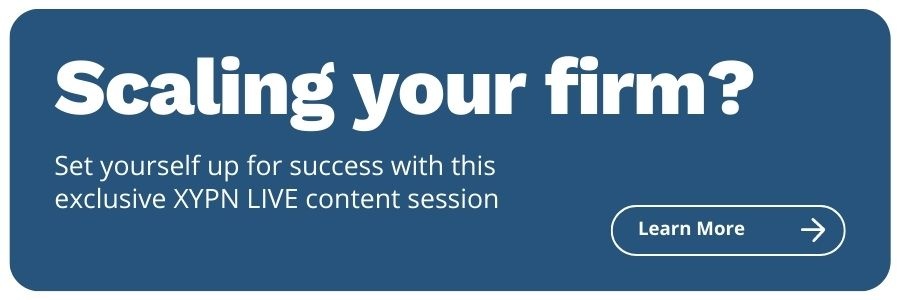How to Reverse Engineer Your Business Goals: What Would Arlene Say?
Share this
As a coach for financial planners, I’m always surprised by how many of my clients struggle to set goals that reflect how they want to grow.
When it comes to setting goals, entrepreneurs tend to be very action-oriented and forward-thinking. I’ve seen clients set clear, tangible goals for everything in their businesses from gross revenue to clients signed to hours worked per week.
Unfortunately, these goals aren’t always rooted in a clear “why.”
Let’s look at an example that I see often: setting revenue or profit goals. Raise your hand if you’ve ever set a financial goal for your business for a reason that wasn’t directly connected to your lifestyle and business goals. Guilty?
We’ve all been there. Many advisors set revenue and profit goals for their businesses for the wrong reasons. Some of these might include:
- Running a $1 million business feels like the mark of a “successful” entrepreneur
- You read somewhere that a 20% profit margin is above average for small businesses
- Your peers are all grossing $400,000 each year, and you want to reach that gross revenue
While these goals might be valid, if they’re not rooted in a “why” that moves you toward your ideal life, you’re less likely to feel fulfilled if you actually achieve them. When you set goals for your business for the wrong reasons, you end up setting other goals for your business that don’t actually serve you.
For example, if you’ve decided you want to double your revenue this year to reach the average revenue of fellow advisors in your mastermind group, you might:
- Scramble to hire someone to take work off your plate so that you can scale, even if they aren’t a perfect fit
- Agree to take on non-ideal clients who you don’t enjoy working with
- Pursue a niche that doesn’t resonate with you
- Spend time and energy on advertising and marketing that’s focused on short-term gains, not long-term brand recognition and sustainable practices
Ultimately, when you set goals that aren’t connected to your why, you’re much more likely to burn yourself out in the long run. Instead, I recommend reverse engineering your goals for both your business and your life. It may sound a little woo-woo, but I recommend starting with a brief visualization exercise that helps you set a “theme” for the next 12 months. Then, with a clear idea of what you want life to look like in a year or more, you can start to work backward to set goals that will move the needle. Ready? Let’s dive in.
Set An Annual Theme
Have you ever heard of setting a theme for your year? I firmly believe you can do this at any time, and it doesn’t have to be a “New Year” practice. Setting a theme doesn’t have to be a high-pressure practice.
I’ve seen clients set annual themes of growth, process improvement, preparation to scale, client engagement, work-life balance, and more. Your annual theme should reflect where you want to grow to both in business and in life. Don’t limit yourself! The opportunities are endless, and your theme should really resonate with you during this season of your life. If you’re struggling to find a theme that “fits” you can try a quick brainstorming activity. Follow these steps:
- Write a few paragraphs visualizing where you want to be a year from now. Get specific. What does future-you do when you wake up in the morning? How do you feel each day? What tasks fill your work calendar? The more details you can pack in, the better.
- Look through your journal entry. Are you noticing any consistent feelings that pop up in your visualization? For example, you might envision yourself with more free time in your personal life, and a more flexible work schedule. You might see yourself only performing the tasks that you truly love, and skipping admin work that makes your days drag on. In this case, a recurring theme is needing more time, or the ability to free up your schedule.
- Distill what your visualization means for your “theme.” Using the example above, you might decide your theme for the year needs to be scaling or growing your team, to give you more flex in your schedule. Alternatively, you might decide your annual theme is work-life balance, which would allow you to step back and refocus on spending your time in a way you enjoy both in work and in life.
How Does That Theme Show Up In Your Development?
When you look at your year, it’s easy to focus only on your clients and revenue. However, when you set an annual theme, you can take a step back and look at what other goals would intentionally support that theme, and track them accordingly.
Remember: development doesn’t happen in a vacuum. Your theme should run into every aspect of your life and business. Let’s say your theme is Growth. Development might look like:
- Pursuing self-help through a therapist or business coach
- Reading more books
- Focus on business development
- Travel to conferences for networking
- Setting writing or research goals
When your development goals are connected to your theme, you can feel confident that each step you take in your personal and professional life is going to have an impact. You’re not pursuing development for development’s sake - your actions are in line with your dream life and business. That’s a good feeling!
Setting Annual SMART Goals
Once you’ve determined how you want to develop in the next 12 months, you can set yourself up with SMART goals. SMART goals take your theme, and your ideas for development, and make them actionable. A SMART goal is:
- Specific
- Measurable
- Achievable
- Relevant
- Time-bound
You know I love a good acronym! In all seriousness, SMART goals are key because they take your ideas for professional and personal development and make them less nebulous.
Following our previous example, let’s say your theme for the year is Growth, and one of your development ideas is to focus on business development. The truth is that, while business development is certainly a valid step toward growth, it’s not specific enough to be achievable. Annual SMART business development goals might be:
- I will have booked 50 prospect meetings by the end of this year, and signed 25 of those leads.
- In the next 12 months, I will write and publish a prospect-facing white paper.
- I will achieve a new designation.
- My team will have grown by 1 new executive assistant, and 1 new outsourced paraplanner to make scaling easier.
These goals are all growth-oriented, and they’re all focused on helping you develop your business. However, they’re also specific, measurable, achievable, relevant, and time-bound. Looking at these goals, you can easily determine what you need to do each quarter, month, or day to achieve them.
Break Down Your Annual Goals Into Micro-Goals
Now you have a clear idea of where you want to be a year from now and an annual theme to match it. You’ve come up with development ideas and transformed them into annual SMART goals. Your next step is to break your annual goals into micro-goals that keep you on track.
You’re not going to sit down on December 31st and finish a full white paper, or magically sign 24 new clients. Those big, annual goals are going to take time and consistent effort. I recommend having either monthly or quarterly micro-goals that will move you toward accomplishing your bigger annual goals. Looking at our SMART goals above, there are a few clear ways you can break them into 2-3 micro-goals each.
- I will have booked 50 prospect meetings by the end of this year, and signed 25 of those leads.
- Each quarter, I will meet with 12-13 prospects, and sign 6-7 new clients.
- I will do one prospect-facing webinar each quarter to encourage prospects to book a discovery call with me.
- I will attend one networking event each quarter to meet new potential clients.
- In the next 12 months, I will write and publish a prospect-facing white paper.
- Each quarter, I will complete two sections of my eight-section white paper.
- I will submit my work to an editor two sections at a time to break up the work.
- I will achieve a new designation.
- I will spend my first quarter researching different designations and gaining information about which will positively impact my business.
- In quarters two and three, I will enroll in coursework to gain my new designation.
- In Q4 I will focus on wrapping up my designation and promoting this new achievement in my prospect-facing marketing and to both my clients and professional network.
- My team will have grown by 1 new executive assistant, and 1 new outsourced paraplanner to make scaling easier.
- In Q1 I will focus on writing out each of my processes and organizing my workflows.
- In Q2 I will determine whether I need an assistant or a paraplanner first to free up more of my time to meet with new clients and post a job opportunity accordingly.
- By Q3 I will have made my first hire and will determine how much additional revenue I need to feel comfortable making a second hire.
- In Q4 I will post my second job opportunity and hired.
These micro-goals are broken down quarterly, which I find works best for most busy entrepreneurs. However, if you focus on a monthly client service calendar and action items, monthly micro-goals may fit your business more seamlessly.
Once you’ve set your annual theme, and determined your micro-goals, open up your calendar and set dates for yourself to do quarterly intention check-in’s. These should be 30-60 minute sessions where you look at any KPIs you’re tracking, and whether your time is being spent in a way that aligns with your theme.
The truth is that you’re going to get off track at one point or another. Nobody is perfect, and even if you’re dedicated to your annual theme, you might make decisions that don’t fit with the end-goals you’re trying to achieve. Be honest with yourself, and don’t be afraid to course-correct if you get off track.
Daily Habit Building
The only way you’ll achieve your quarterly goals is by building daily habits that support them. These habits should be small, high-impact ways that you can work toward accomplishing your quarterly micro-goals, and ultimately your larger annual goals.
For this example, we’ll just look at writing a prospect-facing white paper. If your goal is to write two sections of your white paper each quarter, you might try setting aside an hour every morning to work on research and writing. If blocking an hour each day seems overwhelming, start smaller. Try writing for a half-hour at the beginning of your workday.
If you find that setting daily habits to achieve your goals is challenging, try habit stacking. Starting new daily or weekly habits can be hard, and “stacking” them on top of existing habits can make it easier to commit to them.
For example, if you’re trying to write for an hour every morning (new habit), you could “stack” it on top of waking up and enjoying a cup of coffee at the kitchen table (existing habit). Grab your laptop and set it at the kitchen table each night. That way, in the morning it’s ready for you to sit down with a fresh cup of coffee for an hour to dive in.
Forming new habits is challenging regardless of whether they’re for your professional or personal development. I find that it’s key to explore different habit-forming strategies to find one that works for you.
You might click into your new routine immediately, but it may take some time. Be open to different ways you can accomplish your new habit and incorporate it into your existing routine. If you’re not a morning person, dedicating 30-60 minutes each morning to writing likely isn’t going to work for you even if your colleague swears by their morning routine. Give yourself some grace, and keep plugging along until you find what works for you.
Remember: You Need to Plan For Both Personal and Professional Development for Well-Rounded Improvement
Focusing on only your business, or only your personal life could result in a pretty uncomfortable imbalance. For well-rounded improvement, you need to focus on both to some degree. If your annual theme is Growth, this might mean focusing on both business development and self-improvement through therapy. Don’t overwhelm yourself by trying to overhaul both your life and your business, but make sure that your annual goals are reasonably balanced.
Of course, there will be seasons where our personal goals outrank our professional goals or vice versa. Even if you have the best of intentions to create balanced goals that contribute to your theme, it’s just not always possible. When you’re setting your goals, think about the season you’re in.
Is being an emotionally present parent your #1 growth goal right now? Will that take time away from your business growth goals? You can always make progress, even in seasons where one aspect of your life is secondary. Keep your current season in mind, and set SMART goals that respect your own boundaries.
Remember: a key to SMART goals is ensuring that they’re achievable. If you know that the next 12 months are going to be full of family-related goals (like having a baby, or caring for an elderly loved one), set your goals in a way that is achievable given your circumstances.
I recently spoke to an advisor who was a single parent. She had just launched her business, but it was her daughter’s senior year of high school. She was determined to not miss anything before her daughter left for college, and that meant slower growth in Year One. When her daughter went to college, she was able to lean into her business confidently, and she shot off like a rocket! My point is, the more you give space for the season you’re in, the more likely you are to find both fulfillment and success in the long-run.
Remember: You Can Do Anything, Not Everything
The beauty of reverse engineering your goals and development from an annual theme is that they’re uniquely tailored to you. The life you envision for yourself a year from now is the life you’re actively working toward with each new daily habit. However, as you’re setting your theme-based goals, it can be easy to bite off too much at once. If you find you’re falling into this trap, remember: you can do anything, not everything.
Stay focused on goals that align with your theme, and go all-in on a limited number of true “goals” you want to accomplish in each area of your life. The more focus you can give them, the more success you’ll have.
 About Arlene Moss, Executive Coach
About Arlene Moss, Executive Coach
Arlene gets a kick out of helping financial advisors get over being overwhelmed and take on their frustrations so their businesses soar. Arlene works to ensure XYPN members are able to help their clients prosper while creating a sustainable business model. Through XYPN Academy and one-on-one coaching, members get the support they need to grow their businesses and overcome the challenges that come their way.
Share this
- Running Your RIA Efficiently: Outsourcing Bookkeeping with XYPN Books
- Road to Launch with XYPN Member Alan Skillern, CFP®, MBA
- Coaching for Better Time Management: Prioritizing Organic Growth in Your Daily Routine
- Boost Your Financial Advisory Practice: SEO Strategies and CRM Optimization for Sales Success
- Advisor Blog (693)
- Financial Advisors (221)
- Growing an RIA (99)
- Digital Marketing (87)
- Marketing (84)
- Community (81)
- Start an RIA (76)
- Business Development (72)
- Coaching (72)
- Running an RIA (70)
- Compliance (69)
- Client Acquisition (65)
- Technology (64)
- XYPN LIVE (59)
- Entrepreneurship (57)
- Sales (49)
- Practice Management (44)
- Client Engagement (41)
- Bookkeeping (38)
- XYPN Books (38)
- Investment Management (37)
- Fee-only advisor (36)
- Lifestyle, Family, & Personal Finance (31)
- Employee Engagement (30)
- Client Services (25)
- Financial Education & Resources (25)
- Journey Makers (21)
- Market Trends (21)
- Process (14)
- Niche (11)
- SEO (9)
- Scaling an RIA (9)
- Career Change (8)
- Transitioning Your Business (7)
- Partnership (6)
- Transitioning To Fee-Only (4)
- Social Media (3)
- Transitioning Clients (3)
- Emerald (2)
- Persona (2)
- RIA (2)
- Onboarding (1)
- Sapphire (1)
Subscribe by email
You May Also Like
These Related Stories

Reducing the Lifestyle Practice Stigma: What Would Arlene Say?
May 17, 2018
12 min read

How to Set Goals as An Established Advisor
Jan 4, 2018
6 min read





